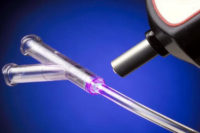HANNOVER, Germany—Engineers at the Fraunhofer Institute for Machine Tools and Forming Technology (IWU) have developed a way for people and robots to work together in an intuitive way that feels like human teamwork. Robots can recognize gestures, faces and postures to make the interaction safe and efficient.
The robot detect can detect a component in the worker’s grasp and cautiously follows it until he or she hands it over. Various safety zones around the robot determine whether and how robot and human can work together in each zone.
“A cursory glance at shop floors is all it takes to see human-robot collaboration has gone mainstream in manufacturing,” says Mohamad Bdiwi, head of the robotics department at Fraunhofer IWU. “However, a second glance reveals that this is more ‘to each his own’ than ‘we’re in this together.’
“Heavy-duty robots operate alongside their human coworkers without safety fencing, but direct interaction is a no-go,” explains Bdiwi. “Safety precautions dictate that the robot freezes as soon as a human sets foot in a sizable surrounding safety zone.
“We have added effective, secure and flexible interaction to legacy technology,” claims Bdiwi. “This is the first time humans can communicate and collaborate directly with robots based on hand gesture.”
According to Bdiwi, the machine recognizes human gestures, faces and postures when a person enters the robot’s work zone. This data serves to make the teamwork safe and to control the robot. The human simply gestures, using hands and arms to instruct the mechanized coworker to perform a task. The robot is able to interpret even complex movements.
“Our technology brings gesture control to industrial applications,” says Bdiwi. “The robot does not only track hands; it also scans faces. For example, if a human glances sideways or rearward to talk to another coworker, the machine knows to ignore gestures meant for others.
“Human and robot can work together directly and even pass parts and tools back and forth,” Bdiwi points out. “The robot sees when a hand is too close to the worker’s face, and waits for it to be extended out of the danger zone before handing the object over. This human-robot interaction comes courtesy of smart algorithms and 3D cameras that lend the robot the power of sight.”



